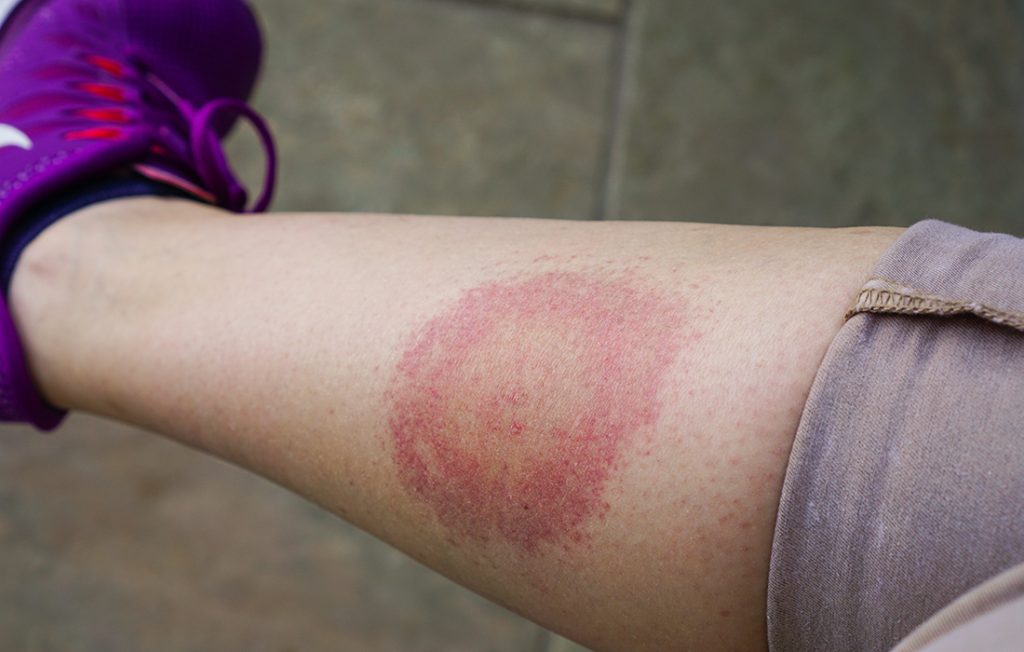Dr Philippa Kaye On Ticks And How To Remove Them

Dr Philippa Kaye tells us how to spot ticks and, more importantly, the best way to remove them, plus what to do if you develop a rash…
During our electronic consultation, Katy sent me a photo of her calf with a rash which had worsened over a few days.
My first question was if she had recently been away from London, where she lives, to the countryside. Katy had had a holiday walking with her husband in Scotland about two weeks ago. With a few more questions, it was clear Katy had the classic rash of Lyme disease and needed antibiotics.
What is Lyme disease?
Lyme disease is due to the bacteria Borrelia Burgdoferia which is passed to humans via tick bites. My question about travel to the countryside was because it is more commonly found in Scotland and Southern England, in particular in countryside areas. Not all ticks are infected with Borrelia and only those who are can pass on the infection. Most in the UK aren’t infected, so a tick bite does not always lead to Lyme disease.
What do ticks look like – and is it easy to spot a rash?
Ticks are tiny insects about the size of a sesame seed which climb onto humans as we brush by in the long grass. If you are bitten, it takes about a day for the bacteria to transfer from the tick into your body, so removing a tick as soon as you see it will decrease your risk of infection.
However you may not notice you’ve been bitten, and Katy’s rash developed two weeks after her trip.
Generally the first stage of Lyme disease starts 3 to 36 days after a bite, most commonly 1-4 weeks later.
The rash is called erythema migrans and looks like a bull’s eye target with a red circle which spreads slowly outwards leaving a paler circle within it. The rash covers at least 5cm but isn’t itchy. In about a third of cases you may also develop a flu like illness with fever and fatigue for a few days.
Most cases are picked up and treated at this stage but if not, infection can spread round the body causing other symptoms such as joint pains, and even meningitis.
How can I prevent tick bites?
To prevent tick bites, avoid walking through long grass. Tuck trousers into boots and wear long sleeves. Use tick repellent sprays. Once home, check clothes and body for ticks – ask someone else to check the bits you can’t see!
If you find a tick, remove it immediately following these 6 steps:
- Wash your hands.
- Use fine or pointed tipped tweezers or a tick removal tool – available from vets and pet stores.
- Grasp the tick as close to your skin as possible and pull slowly and steadily upwards with even pressure. Avoid jerking or twisting as it makes it more likely you will leave the head/mouth parts.
- If you do notice that parts of the tick have been left, try to remove them.
- Then clean the area with soap or antiseptic and water.
- Wash your hands.
Dr Philippa Kaye explains what NOT to do!
Do not use a pair of blunt ended eyebrow tweezers, or even your fingers to try to remove the tick, as you are more likely to crush it, or remove its body but leave the head attached, meaning you could still get infected.
Don’t try other techniques like smothering the tick with petroleum jelly or burning it, as these increase the risk of the tick vomiting (the vomit contains the bacteria) into the skin and can actually increase risk of infection. Not to mention that burning your skin causes damage! Once removed don’t crush the tick, dispose of it by flushing it away.
Diagnosis and treatment of Lyme disease
If you find a tick on your body and then develop the characteristic bullseye rash see your GP. They will give you antibiotics without waiting for blood test results if the history and rash fit with Lyme disease.
Not everyone develops or notices the rash, so if you develop other symptoms, a blood test can be performed within four weeks of developing symptoms. If that test is negative it can be repeated four to six weeks later as there can be an interval before the body produces antibodies to the infection. Antibiotics will be given if antibodies are found.
Advice given in this article and on the My Weekly website and magazines is not meant to replace personalised medical advice from your doctor. If you have any health concerns please see your doctor.
Article written on August 4, 2022; article reviewed and updated on April 16, 2024
Each week we’ll ask Dr Philippa Kaye to talk about a prominent health issue, so look out for more articles in our health and wellbeing section in coming weeks. Read her advice on Parkinson’s Disease, Shingles, Ovarian Cancer, Endometriosis, Long Covid and Eating Disorders.






